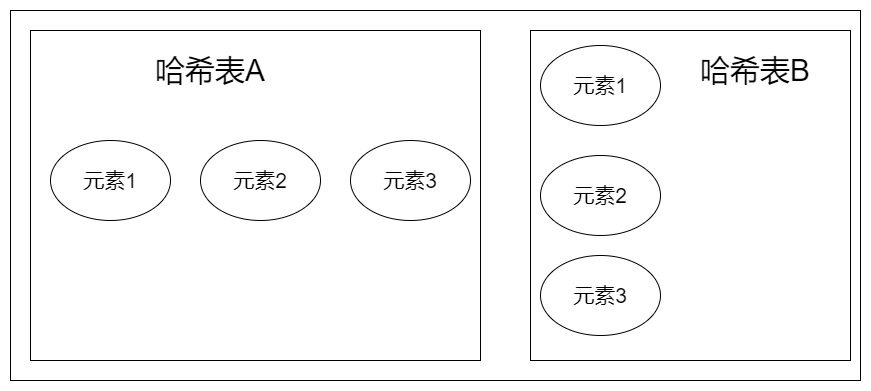HashSet
大约 3 分钟
哈希表存放的是哈希值。HashSet 存储元素的顺序并不是按照存入时的顺序(和 List 显然不同)而是按照哈希值来存的,所以取数据也是按照 Hash 值取的。元素的哈希值是通过元素的 hashCode() 方法获取的,HashSet 首先判断两个元素的哈希值,如果哈希值一样,接着会比较 equals 方法,如果 equals 结果为 true,HashSet 就视为同一个元素。如果 equals 为 false 就不是同一个元素。
哈希值相同 equals 为 false 的元素是怎么存储的呢?就是在相同的哈希值下顺延(可以认为哈希值相同的元素存放在同一个哈希桶中)。也就是哈希值一样的存在同一列中。如下图所示,A表示的是所有元素的哈希值都不同的情况;B表示各元素的哈希值相同的情况。

HashSet 通过 hashCode 值来确定元素在内存中的位置。一个 hashCode 位置上可以存放多个元素。
HashSet实现了Set接口,它的底层是由HashMap来支持的。HashSet的元素实际上是存储在底层HashMap的key上的。由于HashMap的无序不重复特性,HashSet存储的元素也是无序的,并且元素也不能重复,同时也只允许存储一个null元素。
源码分析
主要属性
// HashSet 底层的 map
private transient HashMap<E,Object> map;
// Dummy value to associate with an Object in the backing Map
// 虚拟的值,主要用于与存入的元素,在 HashMap 中构建 key - value 关系(唯一的用途)
private static final Object PRESENT = new Object();HashSet是通过HashMap来保存元素,由于只需要目标元素保存在key中,所以采用虚拟对象PRESENT对应map中的value值的引用。每次向map中添加元素时,每个元素在map中对应的value都是PRESENT。
构造函数
// 默认无参构造
public HashSet() {
map = new HashMap<>();
}
// 根据已有集合元素来构造HashSet
public HashSet(Collection<? extends E> c) {
map = new HashMap<>(Math.max((int) (c.size()/.75f) + 1, 16));
addAll(c);
}
// 给定初始容量
public HashSet(int initialCapacity) {
map = new HashMap<>(initialCapacity);
}
// 给定初始容量和加载因子
public HashSet(int initialCapacity, float loadFactor) {
map = new HashMap<>(initialCapacity, loadFactor);
}
// 这个构造函数外部不能调用,供LinkedHashSet复写
HashSet(int initialCapacity, float loadFactor, boolean dummy) {
map = new LinkedHashMap<>(initialCapacity, loadFactor);
}重要方法
/**
* Returns the number of elements in this set (its cardinality).
* 长度
* @return the number of elements in this set (its cardinality)
*/
public int size() {
return map.size();
}
/**
* Returns <tt>true</tt> if this set contains no elements.
* 是否为空
* @return <tt>true</tt> if this set contains no elements
*/
public boolean isEmpty() {
return map.isEmpty();
}
/**
* Returns <tt>true</tt> if this set contains the specified element.
* More formally, returns <tt>true</tt> if and only if this set
* contains an element <tt>e</tt> such that
* <tt>(o==null ? e==null : o.equals(e))</tt>.
* 连接
* @param o element whose presence in this set is to be tested
* @return <tt>true</tt> if this set contains the specified element
*/
public boolean contains(Object o) {
return map.containsKey(o);
}
/**
* Adds the specified element to this set if it is not already present.
* More formally, adds the specified element <tt>e</tt> to this set if
* this set contains no element <tt>e2</tt> such that
* <tt>(e==null ? e2==null : e.equals(e2))</tt>.
* If this set already contains the element, the call leaves the set
* unchanged and returns <tt>false</tt>.
* 添加元素
* @param e element to be added to this set
* @return <tt>true</tt> if this set did not already contain the specified
* element
*/
public boolean add(E e) {
return map.put(e, PRESENT)==null;
}
/**
* Removes the specified element from this set if it is present.
* More formally, removes an element <tt>e</tt> such that
* <tt>(o==null ? e==null : o.equals(e))</tt>,
* if this set contains such an element. Returns <tt>true</tt> if
* this set contained the element (or equivalently, if this set
* changed as a result of the call). (This set will not contain the
* element once the call returns.)
* 移除元素
* @param o object to be removed from this set, if present
* @return <tt>true</tt> if the set contained the specified element
*/
public boolean remove(Object o) {
return map.remove(o)==PRESENT;
}
/**
* Removes all of the elements from this set.
* The set will be empty after this call returns.
* 清空
*/
public void clear() {
map.clear();
}